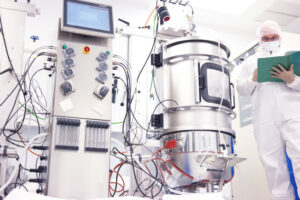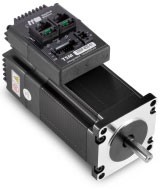Heat issue related to a peristaltic pumps system are solved with closed-loop step motors
Heat problems related to a peristaltic pump system that provides materials to a bioreactor can be solved by replacing open-loop step motors with closed-loop step motors. A peristaltic pump, with internal tubing that separates media from pump components, offers a sanitary method to supply the bioreactor with various fluids to grow cell cultures in the development of new medicines. Step motors are used to drive the pump head, compressing and releasing the pump tubing to move media into the bioreactor chamber.
 Originally, excessive heat generated by open-loop step motors raised the temperature of fluids being pumped into the bioreactor. The higher temperatures, in turn, negatively affected biological processing times and reduced yields. Integrated closed-loop step motors eliminated the heat problem by operating cooler and consuming less power than open-loop step motors.
Originally, excessive heat generated by open-loop step motors raised the temperature of fluids being pumped into the bioreactor. The higher temperatures, in turn, negatively affected biological processing times and reduced yields. Integrated closed-loop step motors eliminated the heat problem by operating cooler and consuming less power than open-loop step motors.
The closed-loop step motor system’s current is controlled to precisely meet torque demands. Drawing only enough current as needed, the closed-loop step motor generates substantially less heat than an open-loop step motor. Closed-loop step motors also run quieter and more smoothly than their open-loop counterparts. Open-loop step motors operate continuously at full current regardless of load requirements, which results in unnecessary heat generation
The life sciences company switched to a StepSERVO™ closed-loop step motor from Applied Motion Products. With doing so they were able to use a single-size NEMA 23 step motor to address all combinations of pump tubing and media instead of stocking different pump and motor sizes. This change to a single motor supported the development of one standard pump head assembly that required only switching tube adapters to dispense different materials to the bioreactor.
 Using an integrated motor design also reduced componentry and decreased space requirements in the control panel. Combining a drive, step motor, encoder, controller and connectors into a single package, the integrated motor removed the need for cabling to connect separate motion control components together, which freed space in the very small control panels. Dual-port Ethernet connections enabled daisy-chain connections of Ethernet signals among multiple motors to reduce network cables routed around the equipment and back to the control panel.
Using an integrated motor design also reduced componentry and decreased space requirements in the control panel. Combining a drive, step motor, encoder, controller and connectors into a single package, the integrated motor removed the need for cabling to connect separate motion control components together, which freed space in the very small control panels. Dual-port Ethernet connections enabled daisy-chain connections of Ethernet signals among multiple motors to reduce network cables routed around the equipment and back to the control panel.
